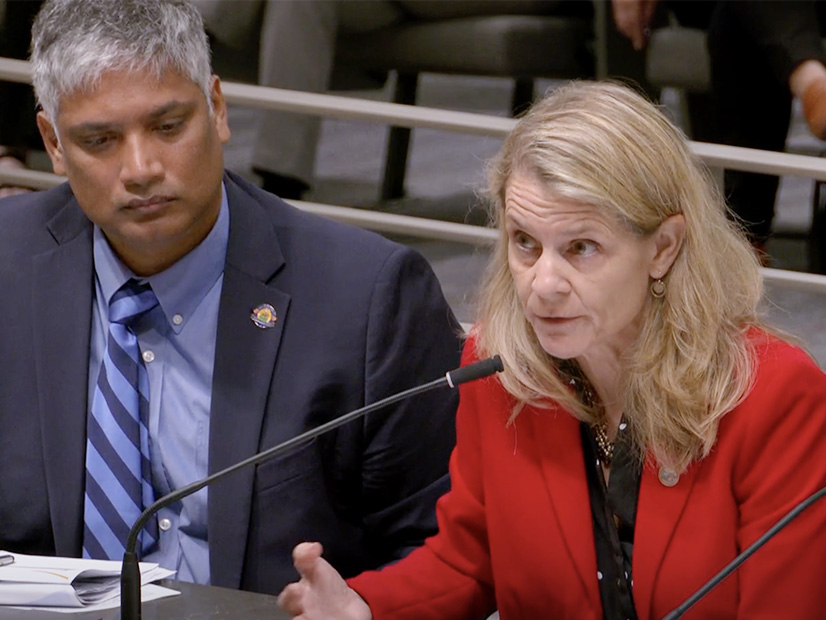
California energy agency heads appearing before state lawmakers Aug. 6 pitched the proposed CAISO governance changes being developed by the West-Wide Governance Pathways Initiative, saying that expanding the ISO’s electricity market will provide for increased reliability and cost benefits for state residents.
Though the initiative has been in the works since last year, the state Senate Energy, Utilities and Communications Committee discussed the topic for the first time during an oversight hearing on electricity reliability. Representatives from CAISO, the California Energy Commission (CEC) and the California Public Utilities Commission (CPUC) participated.
The agency leaders outlined the purported advantages of giving the Western Energy Markets (WEM) Governing Body increased authority over CAISO’s Western Energy Imbalance Market (WEIM) and Extended Day-Ahead Market (EDAM). They also touched on the Pathways Initiative’s evolving plan to establish an independent Western “regional organization” (RO) that eventually would assume more of the ISO’s market functions. (See New Western ‘Regional Organization’ Could be Folsom-based.)
Electricity markets in the West are “very fragmented,” Alice Reynolds, president of CPUC, told the committee. “So, this effort is really thinking about the benefits of a larger market, meaning, think about a market with a footprint that is larger than any one weather event.”
Reynolds said a shared market would allow stakeholders to optimize resources for reliability and tackle different weather events while also maximizing cost savings for ratepayers. However, she noted that proposed changes under the Pathways Initiative would not involve alterations to CAISO’s balancing authority area, a key concern for California labor groups that blocked previous legislative efforts to “regionalize” the ISO and now say they support a bill to enact the Pathways plan. (See California Labor Groups Affirm Support for Pathways Proposal.)
Sen. Henry Stern (D) asked what additional economic benefits California ratepayers could expect from the state’s participation in the EDAM compared with those currently seen in the WEIM, which provided its participants $365 million in estimated benefits during the second quarter of 2024, according to CAISO. (See WEIM Yields $365M in Q2 Benefits with Hot Start to Summer.)
CAISO CEO Elliot Mainzer said EDAM could double those benefits “on just the economic side” but emphasized the impact of an expanded market on reliability.
“The reliability element is becoming increasingly important. I think as you see the reduction in the number of energy emergency alerts, that’s our goal,” Mainzer said. “We want to keep the system calm. We want to have that wide area of visibility. We want to understand not only what’s happening in California, but what’s happening in the broader West, so that on a day-ahead basis, we’ll have the ability to move power to where it’s most needed, given the capabilities of the transmission system.”
‘Really Good Proposal’
On May 31, the initiative’s Launch Committee unanimously endorsed Step 1 of the “stepwise” proposal issued in April. The Launch Committee presented CAISO with the proposal on June 5, which would revise CAISO’s WEIM charter to elevate the oversight position of the market’s Governing Body over WEIM/EDAM matters to “primary” authority, rather than the “joint” authority it currently shares with the ISO’s Board of Governors.
CEC Vice Chair Siva Gunda said the proposal focuses on furthering the independence of CAISO’s governance structure “to have more people feel confident and comfortable to join the EDAM.”
He noted the proposal also clarified the dual filing — or “jump ball” — process that would occur if the CAISO board disagrees with a market rule filing approved by the WEM Governing Body and submits a parallel filing with FERC.
“There will be a dispute resolution if the boards don’t agree,” Gunda said. But “if the dispute resolution did not bring the two boards together, there is a jump ball filing to FERC, meaning both boards can put their proposal to FERC.”
The CAISO board is expected to vote on the first step of the proposal during a joint meeting with the WEM Governing Body later this month.
Gunda told the senators the Pathways Launch Committee expects to issue a proposal on the effort’s next steps in the fall. (The committee is targeting a Nov. 15 release.) Not explicitly described by Gunda but widely understood by industry stakeholders is that the Step 2 proposal will cover the changes to California law needed to migrate some of CAISO’s market functions to the RO, give the RO sole authority over the WEIM/EDAM and allow the ISO to participate in the new entity.
“I just hope you take the next step,” Stern said. “I think you put a really good proposal on the table.”
However, Sen. Kelly Seyarto (R) questioned whether there has been enough outreach to inform the public about the initiative’s implications, saying, “this is the first time I’ve even seen this.”
“I don’t know what our outreach is to the public and when those meetings are, but this is something important for people to understand,” Seyarto said.
“If it’s something that is just kind of part of a box to check off, ‘oh yeah, we did public meetings, we did this, and now we’re doing this,’ you’re going to have a lot of pushback from the public. Because anything that they think might raise their rate right now — they’re hypersensitive to it,” Seyarto added.
Robert Mullin contributed to this article.


